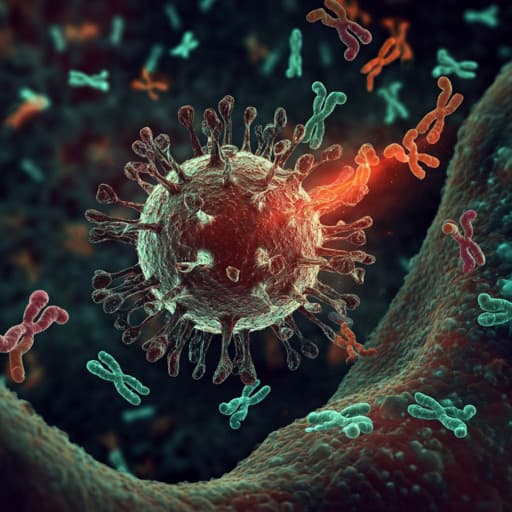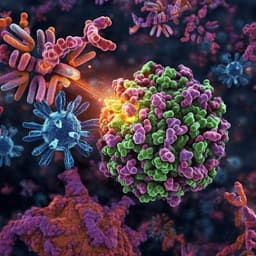
Biology
Humoral and T Cell Immune Responses against SARS-CoV-2 after Primary and Homologous or Heterologous Booster Vaccinations and Breakthrough Infection: A Longitudinal Cohort Study in Malaysia
J. Y. L. Fu, M. H. Pukhari, et al.
A groundbreaking study conducted by J Y L Fu and colleagues in Malaysia reveals how both homologous and heterologous COVID-19 booster vaccinations impact immune responses. The research illustrates that vaccinated individuals exhibit robust neutralizing antibodies against SARS-CoV-2 variants, leading to new insights into flexible vaccination strategies.
~3 min • Beginner • English
Introduction
The Omicron variant (B.1.1.529) rapidly became globally dominant, harboring extensive spike mutations that increase infectivity and facilitate escape from vaccine-induced neutralizing antibodies. Antibody responses after two vaccine doses wane over time and show markedly reduced neutralization of Omicron, while T cell responses appear more stable and cross-recognize variants. Prior studies often focused on healthcare workers, used convenience samples, or had short follow-up, and few Asian cohorts have longitudinally profiled both neutralizing antibodies and T cell responses within the same individuals. Malaysia implemented primary vaccination with BNT162b2 (BNT), ChAdOx1-S (ChAd), and others, and rolled out boosters (mostly BNT), creating cohorts with homologous and heterologous regimens. This study aimed to longitudinally assess neutralizing antibody and T cell responses after primary vaccination and BNT booster (homologous vs heterologous), and to evaluate the impact of breakthrough infection on these responses, informing policy on mix-and-match vaccination strategies.
Literature Review
Evidence shows Omicron substantially escapes neutralization elicited by two doses of mRNA and vector vaccines, though boosters increase cross-neutralization yet remain lower than against WT. T cell reactivity to Omicron is largely preserved. Vaccine-induced immunity wanes, and hybrid immunity (infection plus vaccination) broadens and strengthens antibody responses. Heterologous ChAd/BNT regimens can yield strong humoral and cellular responses after two doses, while three-dose homologous and heterologous regimens often show comparable effectiveness. Neutralizing antibody titers correlate with protection from symptomatic infection, whereas T cells likely sustain protection from severe disease. Prior Asian data and simultaneous longitudinal antibody–T cell measurements within individuals have been limited, motivating this cohort analysis in Malaysia.
Methodology
Design: Longitudinal cohort recruited 26 Aug 2021–8 Mar 2022. Of 100 enrolled, 27 were excluded (missed time-points, incomplete data, or mid-study infection), yielding 73 participants divided into five groups: (1) uninfected receiving two BNT doses (n=25); (2) post-COVID-19 individuals receiving two vaccine doses (n=8; any vaccine for primary course); (3) BNT-primed uninfected receiving BNT booster, homologous booster group (n=14); (4) ChAd-primed uninfected receiving BNT booster, heterologous booster group (n=15); (5) individuals with breakthrough infection after three BNT doses, homologous booster breakthrough group (n=11). Prior infection confirmed by laboratory diagnosis; breakthrough defined by anti-nucleoprotein positivity (Elecsys Anti-SARS-CoV-2).
Sampling schedule: For primary series (two doses 21 days apart), plasma at T1 (pre-dose 1), T2 (21 days after second dose), T3 (3 months after second dose). For booster, plasma at B1 (pre-booster), B2 (21 days post-booster), B3 (3 months post-booster); homologous booster group had B4 (6 months post-booster). Median interval from second dose to B1: homologous 199 days (181–211), heterologous 153 days (110–180).
Assays:
- Serology: Elecsys Anti-SARS-CoV-2 S (anti-RBD, reactive ≥0.80 U/mL) and Elecsys Anti-SARS-CoV-2 (anti-N, COI ≥1.0 reactive) per manufacturer instructions; post-second/booster samples diluted 1:50.
- Neutralization: SARS-CoV-2 pseudovirus neutralization assay using HEK-293T-ACE2-TMPRSS2-mCherry cells. Pseudoviruses bearing WT spike or Omicron (B.1.1.529) generated by transfection of HEK-293T with spike expression plasmids (WT pTwist, Omicron plasmid), psPAX, and luciferase reporter (pLenti CMV PURO LUC). Heat-inactivated sera serially diluted (1:10–1:320), incubated with 1.5×10^5 RLU pseudovirus, infected cells for 48 h; luciferase readout. IC50 determined by nonlinear regression; IC50 <1:10 considered negative (assigned value 5 for analyses). WT and Omicron neutralizations tested in parallel.
- T cell responses: QuantiFERON SARS-CoV-2 IFN-γ release assay with Ag1 (CD4+ epitopes from S1/RBD), Ag2 (CD4+/CD8+ epitopes from S1/S2), Ag3 (Ag2 plus additional immunodominant CD8+ epitopes from spike, nucleoprotein, membrane). Whole blood incubated 16–24 h; IFN-γ quantified by ELISA; positivity cutoff 0.15 IU/mL; values normalized to nil control.
Statistics: Group differences in age and intervals by unpaired two-tailed t-test; sex and positive rates by Fisher’s exact test; within-group time-point comparisons by Wilcoxon matched-pairs signed rank test; between-group comparisons at same time-point by Mann–Whitney U-test. Normality assessed by D’Agostino–Pearson test. Antibody–T cell correlations by Spearman’s rho. Two-sided p<0.05 significant. Analyses via GraphPad Prism. Ethics approval obtained; informed consent collected.
Key Findings
- After two vaccine doses, uninfected vs post-COVID-19:
- Uninfected (n=25): 84% (21/25) showed increased neutralizing antibodies (NAbs) against WT by 21 days post-second dose (p<0.0001); neutralization against Omicron was near detection, 18.4-fold lower than WT (p<0.0001). By 3 months, WT NAbs waned significantly (p<0.0001); Omicron remained near detection and 6.1-fold lower than WT (p=0.0002).
- Post-COVID-19 (n=8): Pre-vaccination, some retained low WT NAbs; only 1 had Omicron NAbs. Two doses induced high NAbs against WT (p=0.0076) and Omicron (p=0.0156). By 3 months, WT NAbs dropped 2.8-fold (p=0.0156) while Omicron NAbs remained stable. Across all time-points, post-COVID-19 had significantly higher NAbs against WT and Omicron than uninfected.
- T cells: CD4+ and CD8+ responses detected in all individuals 21 days post-second dose. Post-COVID-19 had higher CD4+ Ag1 responses (median 3.4 IU/mL, IQR 0.7–6.6) than uninfected (median 0.7, IQR 0.3–1.8; p=0.0357). Both groups’ T cell responses declined to low but detectable levels by 3 months.
- Correlations: Uninfected showed weak negative/near-zero antibody–T cell correlation (rho −0.03 to 0.10); post-COVID-19 showed moderate positive correlation (rho 0.28–0.57).
- Booster responses (homologous BNT-primed+BNT vs heterologous ChAd-primed+BNT):
- Pre-booster: In homologous group (n=14), 71% (10/14) retained low WT NAbs at ~6 months; Omicron NAbs 6.6-fold lower than WT (p=0.002). In heterologous group (n=15), 93% (14/15) had lost detectable NAbs to both WT and Omicron.
- Post-booster (21 days): Homologous group had high WT NAbs (p=0.0001) and moderate Omicron NAb rise; Omicron NAbs 5.1-fold lower than WT (p=0.0001). Heterologous group had high WT NAbs (p<0.0001) but limited Omicron NAbs initially, 7.3-fold lower than WT (p<0.0001). By 3 months, NAbs against WT and Omicron waned in both groups; WT NAbs remained higher in homologous group; Omicron NAbs converged to similar levels between groups.
- T cells: Before booster, T cell responses detected in 79% (11/14) of homologous vs 47% (7/15) of heterologous group; homologous had higher Ag1 (p=0.0005), Ag2 (p=0.0017), Ag3 (p=0.015). Boosters induced robust Ag1/Ag2/Ag3 responses in both groups. By 3 months, heterologous group showed significant waning (Ag1 p=0.0021; Ag2 p=0.0277; Ag3 p=0.0014) with only 47% detectable vs 79% in homologous. At 6 months, homologous Ag3 declined (p=0.0052) but remained higher than heterologous at 3 months. Ag2 generally stimulated stronger responses than Ag1.
- Correlations: BNT-primed group showed strongest antibody–T cell correlations pre-booster (rho 0.55–0.75), remaining moderate up to 6 months (rho 0.35–0.53). ChAd-primed pre-booster showed negative correlation with Ag1 (rho −0.13) and moderate with Ag2 (0.44) and Ag3 (0.32); correlations remained weak post-booster except Ag3 at 3 months (rho 0.79).
- Breakthrough infections (homologous booster group, n=11):
- Occurred 111–141 days post-booster; B4 collected 61–93 days post-infection; all asymptomatic or mild (WHO 0–2).
- Prior to infection, NAbs similar to non-breakthrough counterparts. Booster increased WT and Omicron NAbs at 21 days (both p=0.001), with Omicron 5.2-fold lower than WT (p=0.001); NAbs waned by 3 months; two individuals had absent Omicron NAbs at 3 months. Post-breakthrough, NAbs rose significantly against WT and Omicron (both p=0.001).
- T cells: Booster raised Ag1 (median 0.5 IU/mL, p=0.0322), Ag2 (median 1.0, p=0.0098), Ag3 (median 0.7, p=0.0137). Responses declined by 3 months (Ag2 p=0.042) and did not markedly increase post-breakthrough; one individual had undetectable responses post-infection. Ag2 responses exceeded Ag1 after booster and post-infection; Ag3 exceeded Ag1 before and after infection. Correlations shifted from weak/moderate pre-booster (rho 0.21–0.47) to negative at 21 days post-booster (rho −0.49 to −0.53), then positive by 3 months (rho 0.19–0.30), and moderate post-breakthrough (rho 0.38–0.60).
Discussion
Two primary vaccine doses in uninfected individuals did not elicit substantial Omicron-neutralizing activity and antibody levels waned quickly, whereas previously infected vaccinated individuals developed higher and more durable neutralization against WT and Omicron, consistent with hybrid immunity broadening and strengthening responses. BNT primary vaccination outperformed ChAd in both humoral and cellular immunity up to six months. Following a BNT booster, homologous and heterologous regimens produced similar cross-neutralizing antibodies against Omicron and comparable T cell responses, though homologous boosting yielded higher WT neutralization and more sustained T cell detectability over time. Breakthrough infection during the Omicron-dominant period significantly augmented neutralizing antibodies but did not robustly boost T cell responses, suggesting variant-specific and disease-severity-related constraints on T cell boosting. Overall, the findings support the role of T cells in maintaining protection against severe disease despite declining antibodies and indicate that mix-and-match booster strategies can achieve comparable cellular immunity and Omicron cross-neutralization, informing public health policies under vaccine supply constraints.
Conclusion
Neutralizing antibody and T cell responses were detectable up to three months after both the second dose and a booster. Homologous BNT boosting provided stronger WT humoral responses, while cross-neutralization of Omicron and T cell responses were similar between homologous BNT and heterologous ChAd/BNT boosters. Antibody–T cell correlations were moderate for homologous boosting up to six months and weak for heterologous boosting up to three months. Breakthrough infections after homologous boosting significantly increased neutralizing antibodies but not T cell responses. These results support flexible use of homologous or heterologous booster regimens in public health policy, especially when specific vaccine supplies are limited.
Limitations
- Lack of cohorts primed with BNT followed by ChAd booster and of participants receiving bivalent BNT162b2 boosters.
- Participants, especially in booster cohorts, were mostly healthy and relatively young, limiting generalizability to elderly and specific patient groups.
- QuantiFERON SARS-CoV-2 assay has a restricted detection window and may miss longer-term T cell responses detectable by research assays beyond ~6 months.
- Small sample sizes and short follow-up (up to 6 months) limit long-term durability assessments; heterologous booster group was not assessed beyond 3 months in some analyses.
Related Publications
Explore these studies to deepen your understanding of the subject.







